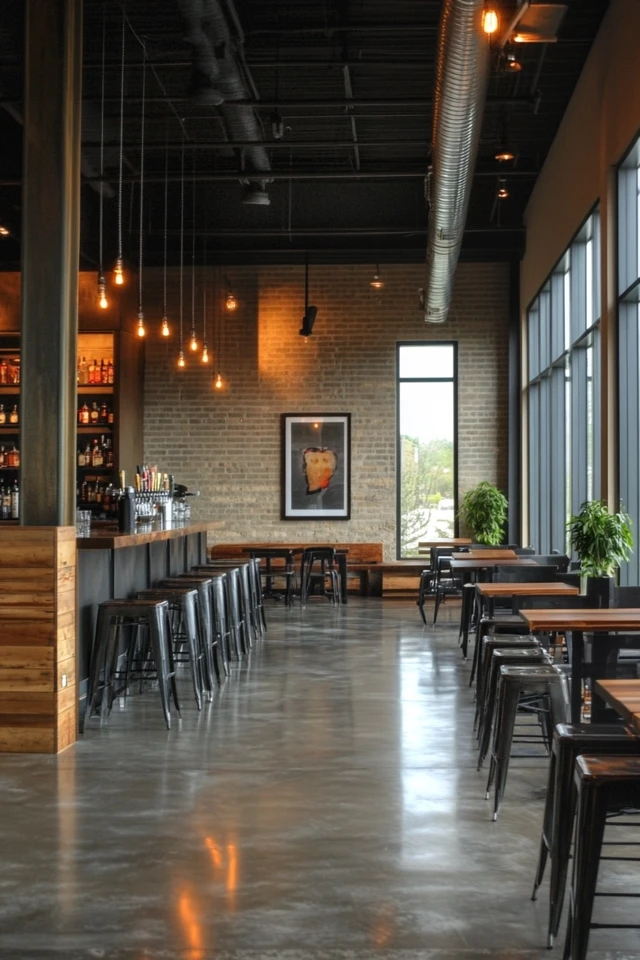Introduction
Open floor plans and industrial design are a match made in architectural heaven. The expansive layouts of open-concept spaces provide the perfect canvas to showcase the raw, edgy charm of industrial aesthetics. From exposed beams and ductwork to concrete floors and oversized windows, an industrial space thrives in openness, allowing natural light and functional design to shine.
My fascination with this design style began when I visited an old converted warehouse turned loft. The open floor plan allowed for uninterrupted views of its brick walls, steel columns, and reclaimed wood furniture. It was breathtaking—every element had room to breathe, yet the space felt cohesive and inviting. When I later moved into my own open-plan apartment, I couldn’t resist recreating that industrial vibe. It became a project of balancing raw materials, smart layouts, and thoughtful décor to make the most of the expansive space.
If you’ve been dreaming of creating a bold yet functional industrial space with an open floor plan, this guide is for you. Let’s explore the key elements, layouts, and design techniques to transform your home into an industrial masterpiece.
The Perfect Design for You
Industrial spaces with open floor plans are ideal for those who love modern, urban aesthetics and crave a sense of freedom in their living environment. This style suits large lofts, studios, or even suburban homes with interconnected rooms. By embracing an open layout, you can celebrate the architectural bones of your space while creating a seamless flow between living, dining, and working areas.
What makes this design so appealing is its versatility. Whether you’re drawn to a minimalist approach or prefer layering textures and colors, industrial spaces offer endless possibilities for customization. With an open floor plan, you can truly let the materials and furniture define the space, creating a home that feels both functional and artistic.
Picture Gallery






Why These Key Elements Work So Well Together
The beauty of an industrial space with an open floor plan lies in its ability to combine raw, structural elements with a sense of flow and harmony. Here’s why the key components of this design work so well together:
- Exposed Structural Features:
- Beams, brick walls, ductwork, and pipes serve as natural focal points that highlight the architectural integrity of the space.
- Neutral Color Palettes:
- Shades of gray, black, white, and earthy tones create a cohesive backdrop, allowing individual design elements to stand out.
- Open Layouts:
- The lack of walls fosters a sense of spaciousness and encourages interaction between different functional areas.
- Textural Contrast:
- The combination of rough (brick, concrete) and smooth (glass, metal) surfaces adds depth and visual interest.
- Functional Design:
- Industrial spaces prioritize practicality, with furniture and décor that emphasize both style and utility.
- Lighting:
- Large windows and industrial-style fixtures enhance the openness of the layout while highlighting key features of the design.
Together, these elements create a space that feels authentic, modern, and versatile.
How to Create an Industrial Space With Open Floor Plans: Step-by-Step
1. Highlight Structural Features
- Expose beams, pipes, and ductwork to celebrate the industrial aesthetic.
- Retain or replicate materials like brick, concrete, and metal to create an authentic look.
2. Define Zones With Furniture
- Use rugs, shelving units, or furniture arrangements to define distinct areas (e.g., living room, dining area) without breaking the openness.
- Opt for low-profile or backless furniture to maintain sightlines and the feeling of flow.
3. Choose an Industrial Color Palette
- Stick to neutral tones like gray, white, and black, complemented by natural wood or metallic accents.
- Introduce pops of color through artwork, textiles, or plants to add personality.
4. Incorporate Raw Materials
- Use reclaimed wood for furniture, metal for shelving or fixtures, and concrete for floors or countertops.
- Mix and match materials to create a balanced yet layered look.
5. Layer Lighting
- Install pendant lights, track lighting, or wall sconces with an industrial edge, such as exposed bulbs or matte black finishes.
- Use dimmable lighting to adapt the ambiance for different activities.
6. Keep the Layout Functional
- Ensure there’s enough space for movement between zones while keeping furniture proportional to the size of the room.
- Focus on multi-functional furniture to maximize utility without cluttering the space.
7. Add Greenery and Decor
- Incorporate plants in concrete or metal pots to soften the industrial edge and bring life to the space.
- Use artwork, books, and vintage finds sparingly to add character without overwhelming the open design.
FAQ Section
1. How do I make an industrial open floor plan feel cozy?
Use rugs, textiles, and warm lighting to create defined, inviting zones. Incorporate softer materials like leather, linen, or wool to balance the rawness of industrial elements.
2. Can I create an industrial space in a small open layout?
Yes! Focus on vertical space with tall shelving or exposed beams. Use light colors and mirrors to make the area feel larger while sticking to minimalist furniture.
3. How do I divide an open floor plan without walls?
Use furniture like sofas, bookshelves, or kitchen islands to define spaces. Rugs and lighting can also help create visual separation between areas.
4. What flooring works best for industrial spaces?
Polished concrete, hardwood, or large tiles are ideal choices. If you prefer a softer surface, use large area rugs to add warmth.
5. Can I mix industrial with other styles in an open layout?
Absolutely! Industrial pairs well with rustic, modern, or even eclectic styles. Use a consistent color palette to ensure the design feels cohesive.
Variations
- Minimalist Industrial
- Focus on clean lines, neutral tones, and minimal décor for a sleek, understated look.
- Rustic Industrial
- Add reclaimed wood furniture, vintage accents, and warm lighting to soften the space and enhance its coziness.
- Modern Industrial
- Incorporate polished finishes, glass accents, and bold geometric shapes for a contemporary twist on industrial design.
- Eclectic Industrial
- Mix industrial elements with colorful artwork, patterned textiles, or unique furniture for a personalized, eclectic vibe.
- Budget-Friendly Industrial
- Use DIY techniques like faux brick wallpaper, painted pipes, or thrifted furniture to create the look without breaking the bank.
How to Showcase It
- Seasonal Styling: Update rugs, throw pillows, and décor to reflect the seasons while maintaining the industrial aesthetic.
- Dinner Parties: Use your open layout to host gatherings, highlighting the space’s flow and functionality.
- Creative Workspaces: Add an industrial desk or shelving unit to a corner to create a functional yet stylish home office.
- Social Media Ready: Showcase your industrial space with styled photos that highlight its unique features, like exposed brick or oversized windows.
Occasions to Feature It
- Housewarming Parties: Let guests explore your stunning open floor plan and admire its industrial charm.
- Holiday Gatherings: Use the expansive layout to host festive dinners or parties with ease.
- Everyday Living: Enjoy the practicality and beauty of a space that’s designed for daily comfort and style.
- Creative Projects: Use the open layout to display artwork or tackle DIY projects in an inspiring environment.
Conclusion
An industrial space with an open floor plan is more than just a design choice—it’s a lifestyle. By embracing the raw beauty of exposed materials, thoughtfully arranging furniture, and balancing textures and lighting, you can create a home that feels expansive, stylish, and full of character.
Ready to transform your space? Start by highlighting the architectural elements, defining functional zones, and curating furniture and décor that reflect your style. Whether you’re designing a sprawling loft or a compact studio, an industrial open floor plan offers endless possibilities for creativity and personalization. Share your journey and inspire others to embrace the beauty of open industrial spaces!
Before Reading this Article, Hire Us As Your Designer or Take a Look at My Top 3 Amazon Picks!
If you are looking to blend Amazon's furniture finds with a personalized touch for your space, check out my portfolio, and hire us! You'll get 3 Idea boards, 2 Concept Boards, 2 Realistic Renderings, a Floor Plan, and a Shopping List! Everything's online, plus a 25% discount on your first online interior design project with my Havenly Promo code 4c7441bcfb. With over 2,000 designs since 2017 and top US brand partnerships, your project is in expert hands. US only. Ready to start?




